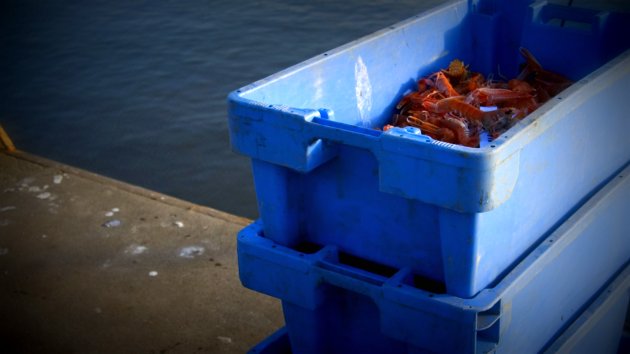Antibiotics Illegal in the US Found in Samples of Foreign Shrimp
Published at
 iStockphoto/Thinkstock(NEW YORK) — With Americans eating more shrimp — more than 1 billion pounds a year or 4 pounds per person — than salmon, crab and trout combined, the crustacean seems to be the U.S.’s favorite seafood.
iStockphoto/Thinkstock(NEW YORK) — With Americans eating more shrimp — more than 1 billion pounds a year or 4 pounds per person — than salmon, crab and trout combined, the crustacean seems to be the U.S.’s favorite seafood.
“It’s all over the menu,” said New Orleans chef Brian Landry of the seafood restaurant Borgne. “The shrimper men hit the dock yesterday morning. By 3 p.m. the shrimp were in our kitchen.”
Landry uses only local gulf shrimp, but most Americans don’t know that 90 percent of the shrimp they purchase at the grocery store — and in most restaurants — never see a shrimper or even a fishing boat.
Most of the fresh shrimp eaten in the United States is raised in small, overcrowded pens on shrimp farms in countries like India, Thailand and Vietnam, according to the federal government. And too often, the shrimp is raised in shockingly disgusting conditions that promote disease.
“A shrimp that’s farm-raised in a foreign country to produce the yield they need and the quantity they need, they’ll use any means necessary that we don’t use here,” Landry said.
To keep the shrimp from dying in diseased waters from their own muck, some shrimp farmers routinely pour antibiotics that are not allowed in the U.S. into their pens — and some of it is reaching U.S. grocery stores.
Because there is so much shrimp flooding the system, though, the Food and Drug Administration currently inspects no more than 2 percent of it. The government says it pressures the foreign shrimp industry to police itself and ramps up inspection on producers who have been caught using banned chemicals.
“Probably 1 [percent] to 2 percent of the products coming in actually get manually inspected,” said FDA commissioner Margaret Hamburg. “We can’t screen every container that comes in, open every box, so what we are doing is [trying] to apply the smartest and best strategy to this, which is a risk-analytic approach.”
“It’s a system that is producing good results,” said Michael Taylor, deputy commissioner for foods at the FDA. “People can be confident that there’s a system in place that does an effective job of minimizing these residues. It’s not perfect. There’s room for improvement. We’re doing a number of things to be able to do that but we think people can have confidence in the safety of seafood.”
The FDA says that despite its zero tolerance policy on antibiotics, an occasional antibiotic-contaminated shrimp is not a danger to consumers.
To find out just how much contaminated shrimp was reaching U.S. grocery stores, 30 samples of fresh shrimp were purchased across the country. Those samples were then sent to the nationally recognized Institute of Environmental and Human Health food lab at Texas Tech University and tested for potentially dangerous antibiotics. Shrimp in three of the 30 samples were found to contain banned antibiotics.
“About 10 percent of them showed evidence of pharmaceutical residue in the muscle tissue alone, which people eat,” said Dr. Ronald Kendall, a professor of environmental toxicology and the institute’s director.
Three different banned antibiotics were found in the shrimp: enrofloxacin, an antibiotic banned in animals that Americans eat because it damages the immune system; chloramphenicol, suspected to cause cancer in humans; and carcinogen nitrofuranzone, which was banned in the U.S. 40 years ago.
Kendall said the detection limit for FDA-approved seafood for nitrofurazone — which can have potential health consequences when ingested or absorbed — was about one part per billion.
“With imported shrimp from international destinations, if you exceed one part per billion, that shipment will probably be terminated,” Kendall said. “In the case of the two sample systems that we received from New York when the shrimp averaged 28 and 29 parts per billion, this considerably exceeded the policy.”
But the FDA’s Taylor said that a small sample size — in this case, the 30 samples tested at Texas Tech — did not give a complete picture of residues in food.
“We do much more sampling than that,” he said. “We have an understanding of these residues that says they are not generally very unusual. We typically do not have illegal residues. When we have them, we take strong action to prevent that product from coming into the country.”
Patty Lovera of Food and Water Watch said U.S. consumers should ask for wild-caught, not farm-raised shrimp. Wild-caught shrimp can run a dollar a pound more but they swim freely and are not held in small pens.
Gavin Gibbons, spokesman for the National Fisheries Institute, a trade group that represents domestic and foreign shrimpers, said companies found skirting the FDA systems — including their home countries — could be barred from exporting to the U.S. He said that he didn’t think more testing was the answer to the problem though.
“Focusing on certain countries or companies is a better use of resources that just testing everything that moves,” he said. “We want the FDA to focus their resources on the country or company that abuses the system.”
Gibbons said that his organization was “disappointed” with Texas Tech’s findings and that it maintained a zero-tolerance policy for unapproved antibiotics.
“Our member companies do their own sampling and testing at different times both in the exporting countries and here in the U.S.,” Gibbons said. “Additionally, many invest in third-party certification programs that review food-safety provisions throughout the value chain.”
Copyright 2012 ABC News Radio


